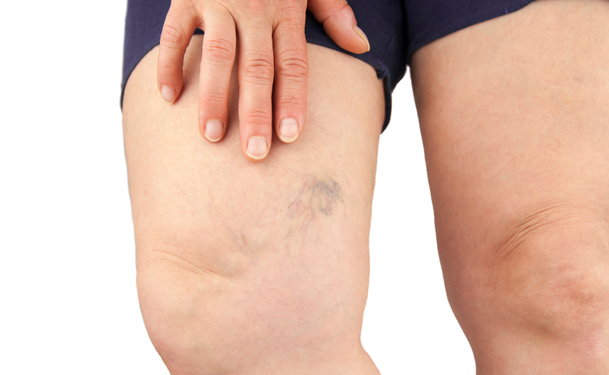Spider veins are a mild form of varicose veins and appear on the surface of your skin as thin red or purple lines or web-like patterns. There are minimally-invasive procedures to effectively remove or reduce the appearance of your spider veins. Learn the causes of spider veins and what the best treatments are.
What are spider veins?
Spider veins, also known medically as telangiectasia or venulectasias, are tiny purple veins near the surface of the skin that appear perpetually dilated and visible. Spider veins commonly appear on the surface of the thighs, calves, and ankles but can also appear on the face. Spider veins aren't always just a cosmetic concern, but can occasionally cause symptoms like swelling, itching, night cramps, fatigue, aching and/or burning.
There are typically three spider-vein patterns:
- A spiderweb shape, where veins radiate out from a central hub
- An "arborizing" pattern that resembles branches on a tree
- Thin, separate lines
In some cases, spider veins may be a symptom of other vein-related conditions. Your doctor will evaluate you for this.
How do you get spider veins?
Spider veins are typically caused by abnormal blood flow in your veins and weakened vein walls. Other factors that contribute to the development of spider veins include:
- Age: The likelihood of developing spider veins increases with age.
- Genetics: Spider veins tend to run in families.
- Prolonged standing or sitting: Not moving around enough can lead to vein damage or make existing vein conditions worse.
- Blunt trauma: Physical damage to your veins can cause them to not work properly and develop spider veins and varicose veins.
- Sun damage: This can lead to spider veins on the face, especially if you're fair skinned.
- Pregnancy and hormonal changes: Pregnancy can increase estrogen (the female sex hormone) in your body, which may weaken your vein walls and contribute to the development of spider veins.
- Obesity: Being overweight puts extra pressure and stress on your circulatory system.
Spider vein removal
Spider veins don't typically go away on their own and usually require treatment. If the underlying cause of your spider veins is a vein disease or other health problem, your doctor will need to address that first.
The two kinds of treatments available for spider veins use either chemical injections or light to shrink your veins so that they eventually fade away and disappear.
Sclerotherapy treatment for spider veins
Sclerotherapy is the most common treatment for spider veins. Your doctor injects a chemical solution into your spider veins with a very fine needle, causing them to eventually shrink, collapse, and eventually disappear. The procedure is done in your doctor's office, is almost pain-free, and there is no down time.
After the injections, your doctor will often compress the treated area with bandages or wraps and have you wear compression stockings for about a week. This makes the procedure more effective and helps you heal.
Sometimes multiple sessions are needed for the best effect.
Light treatment for spider veins
In spider vein laser treatment, a high-intensity beam of light is pointed at the spider veins, heating them up and destroying them, eventually causing them to disappear. Laser treatment is considered the optimal treatment for spider veins on the face and can be used on other parts of the body, but it's rarely used on the legs. It may take multiple treatments for full effectiveness.
Intense pulsed light (IPL) treatment is much like laser treatment, but it's not as precisely focused. IPL uses concentrated pulses of light which selectively damages and destroys abnormal veins, including small spider veins and small vascular birthmarks. Intense light therapy is best suited for vascular lesions located slightly deeper in the skin than those treated with other procedures. This treatment may be recommended when other options can't effectively treat the superficial vein.
Both laser and IPL treatments may be an option for some patients who are unable to undergo sclerotherapy, such as pregnant and breastfeeding women.
Results of spider vein treatments
It can take several weeks to see results from both light-based treatment and sclerotherapy. Not all of your treated veins may disappear completely after a single treatment, so multiple sessions, spaced out, may be needed.
Reviewed March 16, 2017


